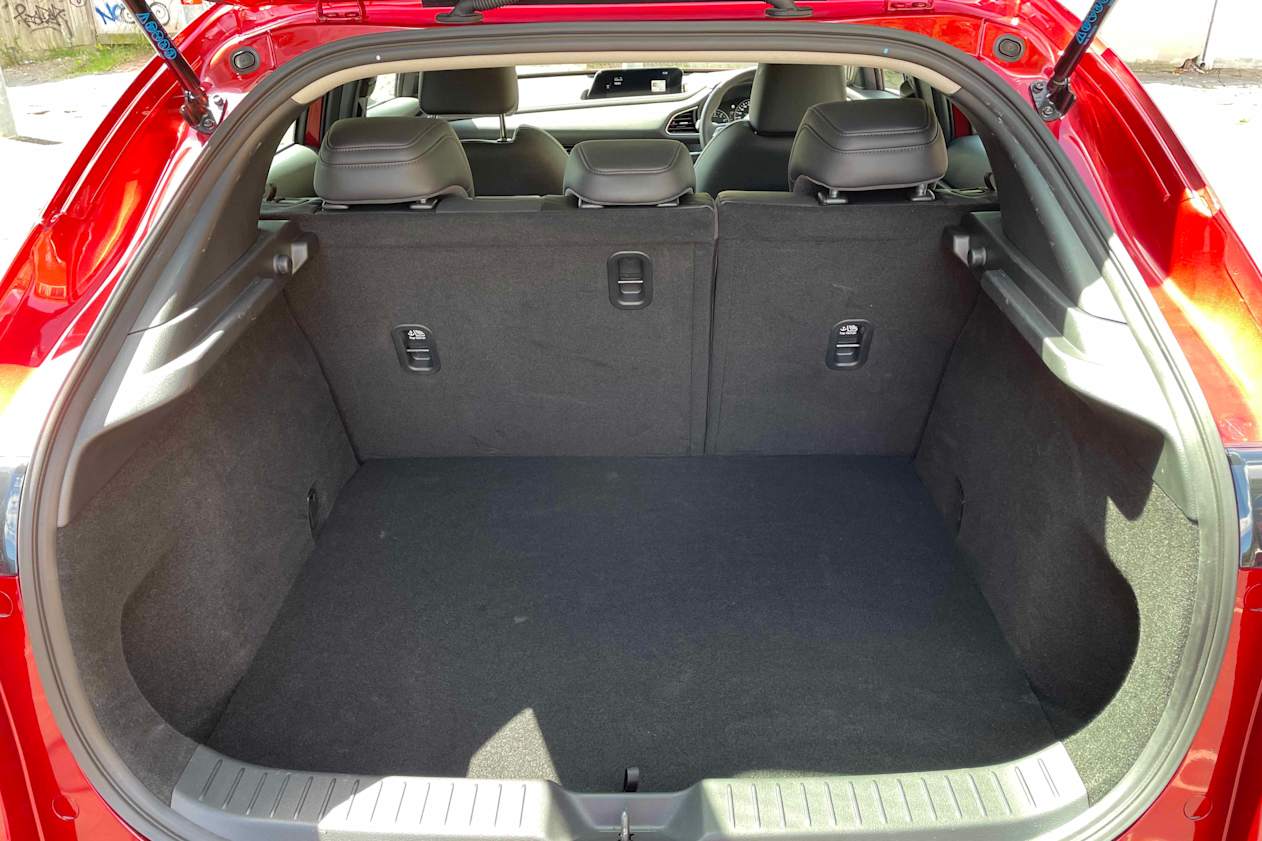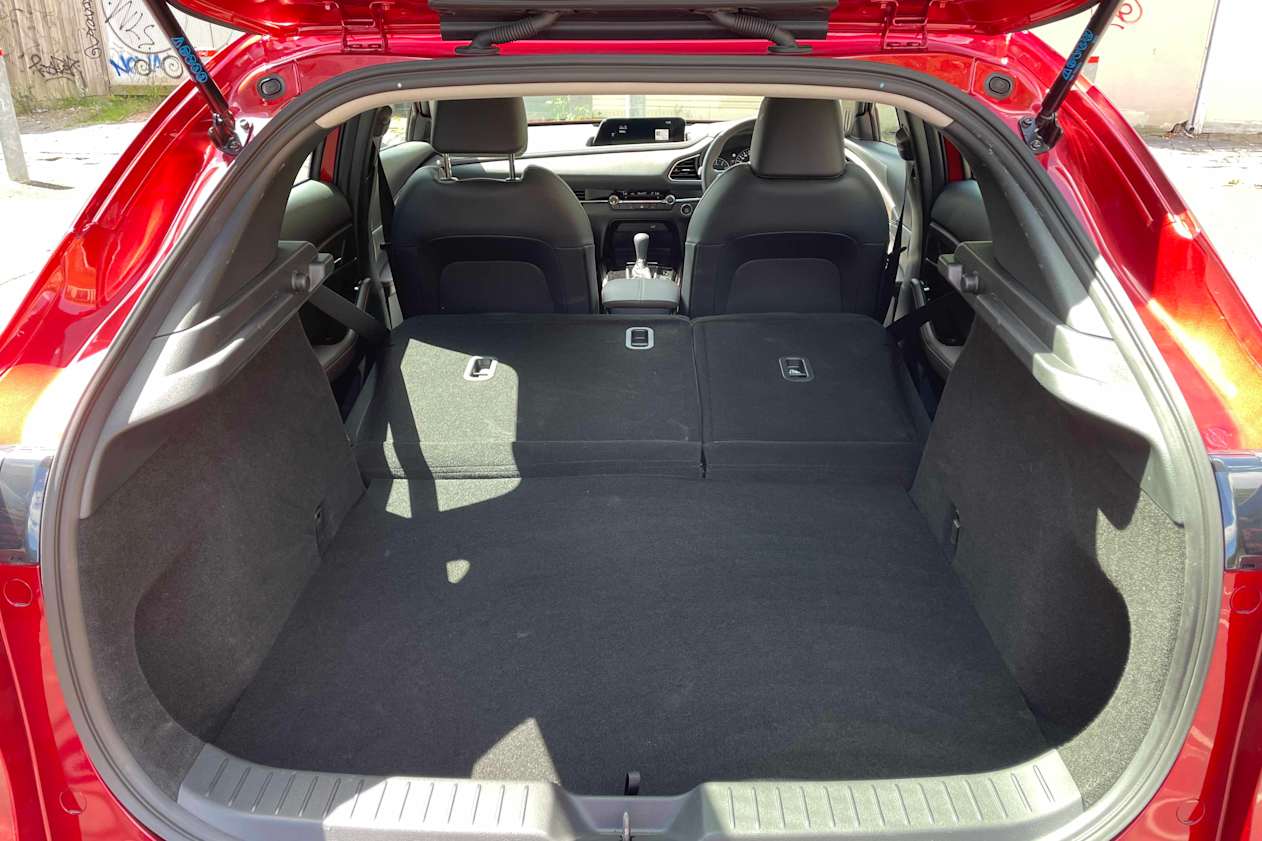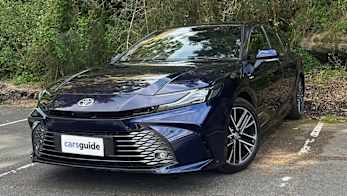It wasn’t that long ago that the Mazda3 small car was the best-selling passenger vehicle in Australia, so it goes without saying an SUV version would sell like hotcakes.
Well, we got the CX-3 light SUV instead, with it based on the Mazda2 hatchback, and needless to say, it wasn’t quite the right fit (read: too tight) for some buyers.
However, patience is a virtue and the Mazda3 of small SUVs is finally here … actually, it’s been on sale for more than 12 months now.
And guess what? The curiously named CX-30 hit the ground running! So, it’s time to take a look at what is possibly its most appealing variant for the urban jungle, the G20 Touring FWD.
Mazda CX-30 2021: G20 Touring (Fwd)
| Engine Type | Inline 4, 2.0L |
|---|---|
| Fuel Type | Unleaded Petrol |
| Fuel Efficiency | 6.5L/100km (combined) |
| Seating | 5 |
| Price From | $21,670 - $27,390 |
| Safety Rating |
|
Is there anything interesting about its design?
9 / 10
In a highly competitive segment, the CX-30 is one slick-looking small SUV. In fact, depending on your opinion, it could be the most attractive of all.

Up front, the CX-30 is unmistakably a Mazda, with the lower edge of its large grille trimmed in chrome, which also props up the slim LED headlights that the G20 Touring FWD unfortunately pairs with halogen daytime running lights.

Around the side the G20 Touring FWD rolls on a nice set of 18-inch alloy wheels, which are wrapped in 215/55 tyres. The fastback style of the CX-30 is also most apparent here, with its roofline quickly tailing off.

At the rear, the G20 Touring FWD’s signature LED tail-lights are prominent, positioned up high on the chunky tailgate, while a rear spoiler adds some sportiness, as do its dual exhaust tailpipes.
Of course, we’re yet to acknowledge the elephant in the room: the CX-30’s love for black plastic cladding. It lays it on thick all the way around to make it obvious that it’s a crossover. Call us crazy, but I think it works in this instance, even if I'm in the minority.

Inside, the CX-30’s two-tone look could be just as divisive, depending on your feelings toward brown, which contrasts with the black (or optional white) leather-accented upholstery and soft-touch and hard plastics in the G20 Touring FWD.
If you ask me, the brown isn’t as jarring as the blue in the CX-30’s entry-level Pure and Evolve grades, but it’s the overall high quality of its interior that should be getting all of the attention.
The switchgear feels superb, and the steering wheel’s stalks are beautifully damped. Better yet, the steering wheel and armrests across both rows are generously padded. We could go on and on about how luxurious all of the little things feel.

Anyway, a 7.0-inch multifunction display is also a welcome inclusion, with it positioned between a traditional tachometer and speedometer, although its functionality is rather limited when to compared to most digital instrument clusters.
Then there’s the ‘floating’ 8.8-inch display to the left. It’s powered by Mazda’s latest multimedia system, coming complete with a sharp set of graphics - but it's not a touchscreen.

Yep, Mazda has doubled down on the rotary controller (with shortcut buttons) that it previously exclusively championed. While somewhat controversial, it’s the right move from a safety perspective, so too is the persistence with a row of physical climate controls.
What I'm not so sure about, though, is the widescreen format of the central panel it operates, with it looking particularly skinny when using the G20 Touring FWD’s in-built satellite navigation or smartphone mirroring (wired Apple CarPlay and Android Auto).
Similarly, the G20 Touring FWD’s windshield-projected head-up display is too small to be completely legible, which is frustrating because it is otherwise well positioned.
How practical is the space inside?
7 / 10
Measuring 4395mm long (with a 2655mm wheelbase), 1795mm wide and 1540mm tall, the CX-30 is on the larger side for a small SUV, but that doesn’t translate across to practicality too well.

For example, cargo capacity isn’t amazing, at 317 litres (VDA), although storage space can be increased to an undisclosed amount by stowing the 60/40 split-fold rear bench, an action that can be performed via the boot with its manual release latches.
The boot itself is quite useful, though, with only a small load lip and floor hump (when the second row is stowed) to contend with, while the aperture is square and four tie-down points but no bag hooks are on hand to secure loose items.
The non-retractable parcel shelf can be removed, but it can’t be stored unfloor, with the space-saver spare wheel and tyre instead occupying that area alongside some related tools.
The G20 Touring FWD is also fairly average in the second row. While two inches of legroom are available behind my 184cm driving position alongside an inch of headroom, it doesn’t tick all of the boxes.

The rear bench isn’t particularly wide, so while three adults can sit on it during shorter journeys, they won’t want to be there on a road trip, particularly with the tall transmission tunnel taking up precious foot space.
Second-row amenities are also lacking, with no connectivity/charging on offer whatsoever and only one map pocket available. Yep, you get directional air vents, a fold-down armrest with two cupholders… and that’s it. Well, the door bins can also each accommodate a regular bottle.

For reference, there are three top-tether and two ISOFIX anchorage points on hand for fitting child seats, but it’s best to test yours before committing, because the fit could prove challenging.
Thankfully, things get a lot better in the front row, where the larger central bin features a USB-A port and a 12V power outlet, while another USB-A port is integrated into the centre stack.

Below it is a small open cubby, in front of which is pair of cupholders concealed by a sliding lid. Then there is the respectably sized glovebox, overhead sunglasses holder and tiny pull-out compartment on the driver’s side. And the door bins can take a large bottle apiece.
Does it represent good value for the price? What features does it come with?
8 / 10
Priced from $34,990 plus on-road costs (MSRP), the G20 FWD is the most affordable variant of the Touring grade, which is positioned between the mid-range Evolve and flagship Astina grades in the CX-30 range.
Standard equipment not already mentioned in the G20 Touring FWD includes dusk-sensing lights, rain-sensing wipers, auto-folding side mirrors with heating, keyless entry and start, digital radio, an eight-speaker sound system, dual-zone climate control and an auto-dimming rearview mirror.
Aside from one other that we’ll get to later, the only option here is paintwork (our test vehicle was finished in stunning Soul Red Crystal metallic, which costs $495 extra), so you get a comprehensive set of features for your money, even if a wireless smartphone charger is missing.
The G20 Touring FWD has many rivals, with its key ones being the MG ZST Essence ($31,490), Hyundai Kona Elite ($31,600) and Volkswagen T-Roc 110TSI Style ($33,990).
What are the key stats for the engine and transmission?
7 / 10
The G20 Touring FWD is powered by a 2.0-litre naturally aspirated four-cylinder petrol engine that produces 114kW of power at 6000rpm and 200Nm of torque at 4000rpm.

This unit is mated to a six-speed torque-converter automatic transmission with paddle-shifters as standard (there’s no manual option here), with drive sent to the front wheels (2WD).
A G25 Touring FWD is available for $1500 extra, with it upgrading to a 139kW/252Nm 2.5-litre unit, while a G25 Touring AWD with all-wheel drive can be had for a further $2000.
How much fuel does it consume?
7 / 10
The G20 Touring FWD’s fuel consumption on the combined-cycle test (ADR 81/02) is 6.5L/100km, while its carbon dioxide (CO2) emissions are 152g/km. Both claims are pretty good for a small SUV.
But in the real world, we averaged 7.5L/100km over 574km of driving, which was heavily skewed towards highways over city roads.
Keeping that mix in mind, that’s an underwhelming result when compared to the aforementioned claim. It just goes to show how hard the G20 Touring FWD has to be worked.
For reference, the G20 Touring FWD’s 51L fuel tank takes more affordable 91RON petrol at minimum.
Warranty & Safety Rating
What safety equipment is fitted? What safety rating?
8 / 10
ANCAP awarded the entire CX-30 range its maximum five-star safety rating in February 2020.
Advanced driver-assist systems in the G20 Touring FWD extend to front and rear autonomous emergency braking, lane-keep assist, adaptive cruise control, blind-spot monitoring, rear cross-traffic alert, traffic sign recognition, high-beam assist, driver attention alert, a reversing camera and front rear parking sensors.
Steering assist, front cross-traffic alert, driver monitoring and surround-view cameras are also included… so long as the $1300 Vision Technology package is optioned. For reference, it wasn’t fitted to our test vehicle.
Two of the active safety features aren’t as good as they should be, with lane-keep assist more reactive than proactive and adaptive cruise control not at all smooth when automatically slowing. Of note, park assist (semi autonomous parking) is neither standard nor optional, but we digress.
Other standard safety equipment includes seven airbags (dual front, front-side and curtain plus driver’s knee) and the usual electronic stability and traction control systems, among others.
What does it cost to own? What warranty is offered?
8 / 10
As with all Mazda models, the CX-30 comes with a five-year/unlimited-kilometre warranty with five years of roadside assistance, both of which are average when compared to Kia’s market-leading seven-year terms with ‘no strings attached’.
The G20 Touring FWD’s service intervals are on the short side when it comes to distance, at every year or 10,000km, whichever comes first. That said, capped-price servicing is available for the first five visits, costing $1836 in total at minimum, which is fairly reasonable.
What's it like to drive around town?
8 / 10
As far as city-focused small SUVs go, the G20 Touring FWD is a winner, but that’s not to say it’s without its faults.
Firstly, the 2.0-litre naturally aspirated four-cylinder petrol engine is well suited to the urban jungle, where driving is slower, such is its character. After all, it sprints from a standstill to 100km/h in a claimed 10.2 seconds…
So, find yourself merging onto a freeway or ploughing along a country road and it quickly becomes apparent how lethargic the little unit really is. Without a turbocharger to provide low-end torque, it needs revs and plenty of them.
For much more palatable acceleration, it’s hard to go past the aforementioned G25 Touring FWD for an extra $1500. Previous experience has shown its 22 and 26 per cent increase in maximum power and torque respectively is very much appreciated.

Either way, the six-speed torque-converter automatic transmission on hand does the job well, with it offering up smooth if not quick gear changes, while it is responsive to throttle inputs when needed. The Sport mode’s higher shift points aren’t ever really needed, then.
Where the G20 Touring FWD – or any other CX-30 variant for that matter – really excels is on the ride and handling fronts.
When it comes to the former, the G20 Touring FWD’s suspension puts in a strong effort, which is good news considering it pairs MacPherson struts up front with a less sophisticated torsion beam at the rear.
While not independent, this set-up deals with most road imperfections with confidence, with only continuously broken surfaces managing to unsettle it, but even so, it’s still more than comfortable.
Better yet, the G20 Touring FWD loves to corner more than most crossovers. Naturally, a higher centre of gravity than the CX-30’s Mazda3 sibling does contribute towards more body roll, but overall control is still strong.
Go hard and the G20 Touring FWD’s 1442kg kerb weight will start to push against it, but the ensuing understeer is never prominent. Indeed, twisty roads can be approached with conviction, should you be in the mood.
And part of the reason why the G20 Touring FWD is enjoyable to drive is its electric power steering, which is well-weighted at higher speeds, not to mention nice and direct.
That said, the system is arguably a touch too heavy at low speed, which makes common manoeuvres like U-turns and parking more challenging. But either way, feedback is solid thanks to the communicative chassis.
Verdict
While not perfect, there’s no doubting the CX-30 is one hell of a debut small SUV, but the variant chosen is very important.
As we found out, the mostly well-specified G20 Touring FWD is agonisingly close to being the best, with it ultimately falling short due its underpowered engine.
That said, for those that rarely find themselves on freeways and country roads, the G20 Touring FWD can and will get the job done. For everyone else, though, the G25 Touring FWD calls strongly.
Either way, so long as practicality isn’t a priority, it’s hard not to be impressed by the CX-30.
Pricing Guides



























.png)








.jpg)

.jpg)



